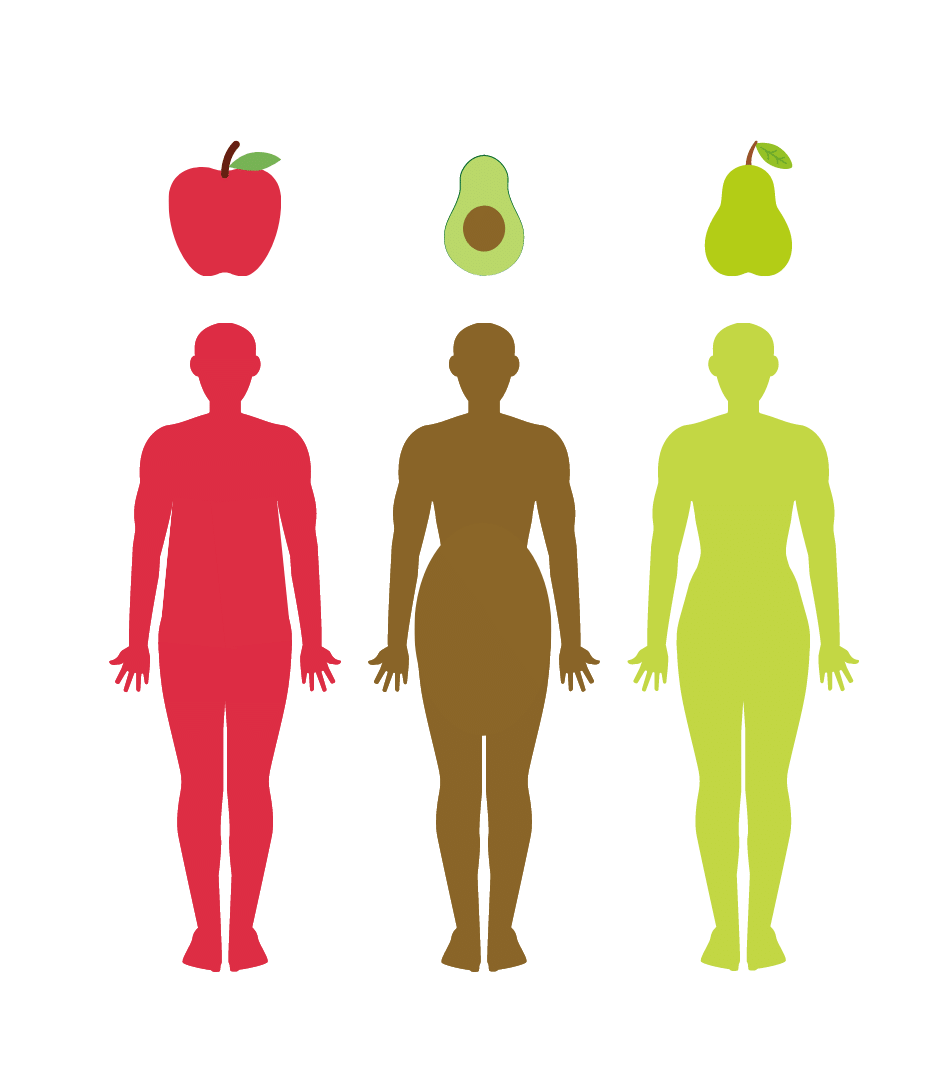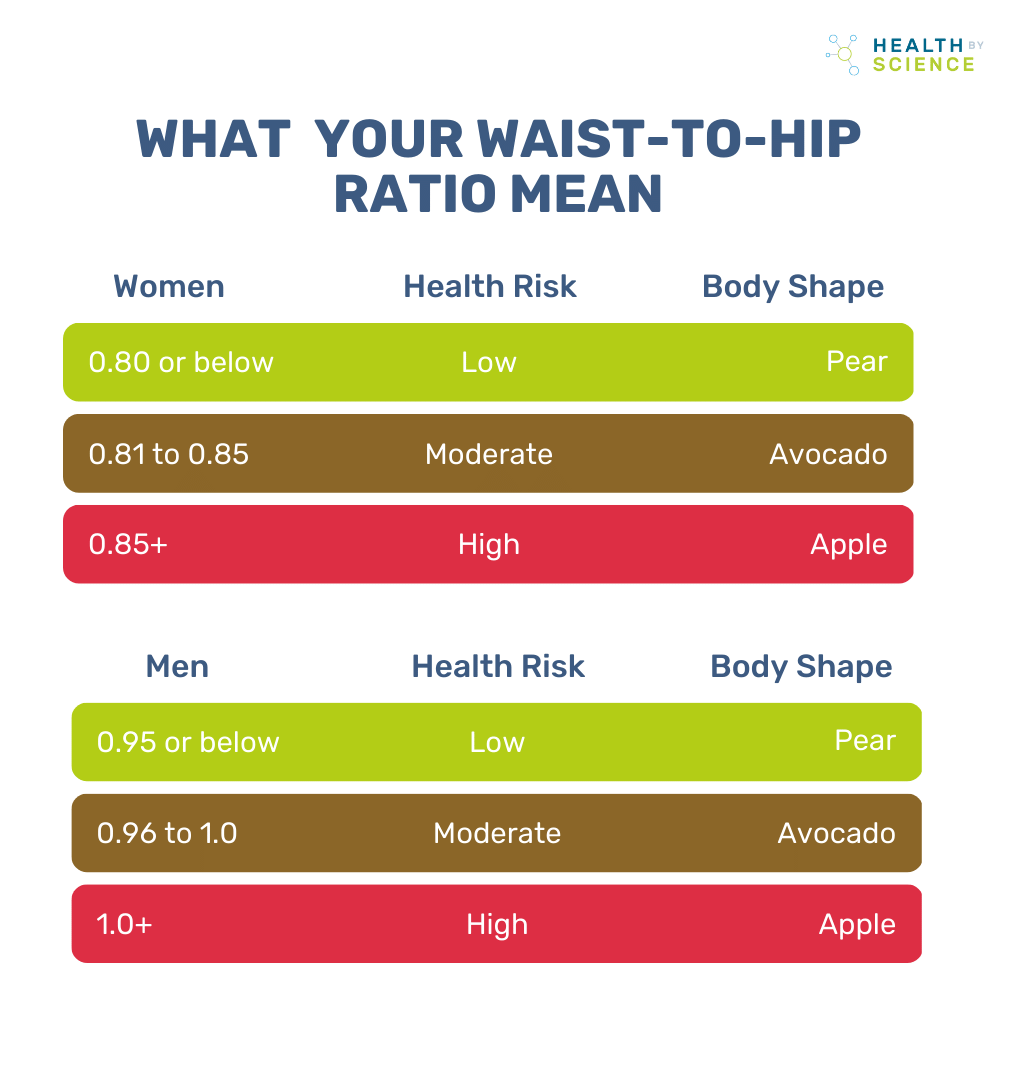According to numerous scientific studies, one of the best indicators for heart attack, stroke and diabetes is...
Body shape.
Surprising right?!
It's more of an indicator than being overweight or being obese.
It's not how much you weigh but where the fat goes that determines your chances of chronic diseases.
In the figure below, there are 3 types of body shapes.
The figure on the far left (the "Apple") shape has the highest risk for heart attack, stroke and diabetes because their waist measures too close to the measure of their hips.
The body shape on the far right ("Pear") has lower risk because their waist measure is much less than their hips.

Not everyone gains weight in the midsection. Some people gain it in their hips, thighs and underarms. But according to science, gaining it around the midsection is the worst.
In this article, I aim to help you understand the importance of reducing your waist circumference AND give you quick tips on how to do it.
HOW TO MEASURE YOUR WAIST-TO-HIP RATIO

- Waist: Wrap a tape measure around your waist at the smallest point, usually around your belly button. This is your waist circumference. Record the number.
- Measure your hips. Next, wrap the tape measure around your hips at the widest part. This is your hip circumference. Record the number.
- Divide. Use a calculator to divide your waist size by your hip size. This is your waist-to-hip ratio.
- Record your ratio. WHO defines abdominal obesity in men as a waist-to-hip ratio of at least 0.90. For women, it’s a ratio of 0.85 or more. A ratio higher than 1.0 for either sex means a much higher chance of health problems.

HOW TO REDUCE WAIST CIRCUMFERENCE
The project of shrinking your waist is 4-fold. But the greatest factor is...
STRESS.
The other important factors include...
- the foods you eat (and don't eat).
- the type of exercises you do.
- the amount of sleep you get.
But the greatest factor is how much stress you allow yourself to feel each day.
HOW DOES STRESS INCREASE WAIST SIZE
Stress can increase cortisol secretion, free radicals, and signal the body to deposit fat and toxins inside and around the belly. The fat surrounding internal organs is called "Visceral Fat". This is the most dangerous type of fat to have.
HOW TO REDUCE STRESS
Here are the top 4 strategies you can employ to manage stress better. Here are some of the best ways:
- Regular Strength Training: The workouts in your Metabolic Reset program is specially designed to reduce stress levels. Especially the "Mat Work" Series. They are designed to help your body release endorphins, which act as natural stress relievers and mood boosters.
- Doing the Restorative Routine (with music): Practicing the Restorative Routine first thing in the morning can help to balance cortisol levels and even resolve chronically high cortisol situations. Individuals become more aware of their body and nervous system allowing them to manage stress more effectively.
- Adequate Sleep: Both the items listed above help you to get a more restful sleep each night. Poor sleep can exacerbate stress and impact overall health.
- Eating Less Processed & Packaged Foods: The low nutrient content and high chemical content in the packaged/processed foods, disrupt your hormone balance causing a hyperactive nervous system. This can trigger more stress than is necessary. A "hyper stress" situation. A well-balanced diet rich in fruits, vegetables, whole grains, and lean proteins can positively impact mood and stress levels.
If you try these 4 steps above but still have difficulty managing stress, you can also try these actions...
Other notable suggestions to reducing stress include:
- Limiting Media Exposure: Reducing exposure to negative news and social media can prevent additional stress triggers.
- Social Support: Maintaining strong social connections and spending time with loved ones can offer emotional support and help buffer against stress.
- Limiting Alcohol: Excessive alcohol intake can worsen stress and anxiety, so moderation is key.
- Time Management: Learning to prioritize tasks, delegate when possible, and avoid overcommitting can help reduce feelings of overwhelm.
- Relaxation Techniques: Incorporate relaxation techniques into your daily routine, such as deep breathing exercises, going for a brisk walk, getting a massage, taking a bath, or spending time in nature.
- Engaging Hobbies: Pursuing hobbies or activities that bring joy and fulfillment can provide a healthy outlet for stress.
- Professional Help: If stress becomes overwhelming or starts to affect daily life significantly, seeking support from a mental health professional, such as a therapist or counselor, can be beneficial
- Laughing and Having Fun: Engaging in laughter and humor can reduce stress hormones and increase feelings of well-being.
- Cognitive Behavioral Therapy (CBT): CBT techniques can help individuals identify and change negative thought patterns that contribute to stress.
- Expressive Writing: Keeping a journal to express emotions and thoughts can be a cathartic way to cope with stress.
Remember, stress reduction is a journey, and what works best can vary from person to person. Experiment with different strategies and find the ones that resonate with you and fit into your lifestyle. If you have any underlying health conditions or concerns, it's always a good idea to consult with a healthcare professional for personalized advice.
Leave me a comment below on what you found most helpful or surprising. Help me help more people. Thanks!
ko
